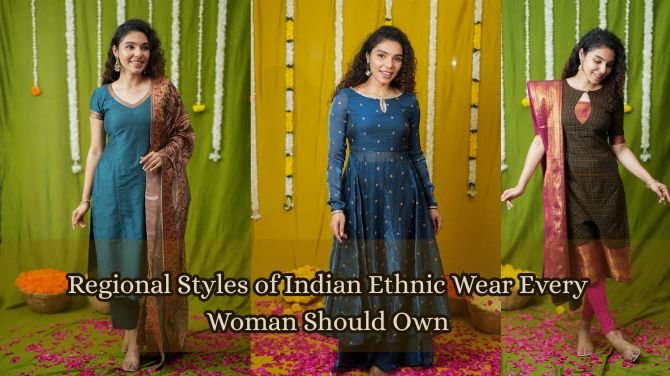India is a land of diverse cultures, traditions, and craftsmanship, and this richness is beautifully reflected in its clothing. Indian Ethnic Wear for Women has always been celebrated for its vibrant colors, intricate embroidery, and timeless appeal. From north to south, east to west, every region offers its own unique style of attire that carries deep cultural significance. For women, building a wardrobe that reflects this diversity is both a fashionable choice and a way to stay connected to tradition. Let’s explore some must-own regional ethnic wear pieces that showcase India’s sartorial brilliance.
1. Sarees from Different Regions
A saree is perhaps the most iconic representation of Indian attire. Yet, it is not just one garment—it comes in countless varieties depending on the region. A Banarasi saree from Uttar Pradesh, with its rich zari work, is perfect for weddings and festive occasions. A Kanjivaram silk saree from Tamil Nadu is treasured for its elegance and is often considered a family heirloom. Bengal’s soft and lightweight Tant sarees are known for comfort and grace. Owning at least one saree from each region adds heritage and versatility to any wardrobe.
2. Salwar Suits and Anarkalis from North India
The northern states of India popularized salwar suits and Anarkalis, outfits that are both comfortable and versatile. These ensembles feature flowing silhouettes, intricate embroidery, and a regal charm that makes them suitable for everything from casual wear to weddings. A heavily embroidered Anarkali can even serve as one of the best Wedding Party Dresses for Women, ensuring grace without compromising comfort.
3. Lehenga Choli from Gujarat and Rajasthan
The lehenga choli is a festive favorite, especially in western India. With swirling skirts, mirror work, and vibrant colors, these outfits bring out the joy and energy of Indian celebrations. Rajasthan and Gujarat are famous for their mirror work and bandhani (tie-dye) lehengas, making them an excellent choice for Navratri dances and festive gatherings. Over time, lehengas have also become a staple bridal outfit, symbolizing royalty and beauty.
4. Langa Davani Dress from South India
One of the most graceful regional outfits is the Langa Davani Dress, also known as the half saree, worn widely in South India. Traditionally worn by young women, it consists of a long skirt (langa), blouse (choli), and a dupatta draped in saree-like fashion. This attire beautifully blends modesty with elegance and has seen a modern revival in designer collections. With silk fabrics and zari borders, Langa Davani is still a popular choice for festive occasions and temple visits.
5. Pattu Pavadai from Tamil Nadu and Karnataka
Another gem from the south is the Traditional Pattu Pavadai, especially popular for young girls but also adapted in graceful designs for women. Crafted in luxurious silk with vibrant hues and gold accents, this outfit is deeply associated with cultural rituals and festivals. Often worn during Diwali, weddings, and religious ceremonies, the pattu pavadai reflects the pride of southern craftsmanship and tradition.
6. Dupattas and Shawls from North India
While they may seem like accessories, dupattas and shawls carry significant cultural weight in Indian fashion. Phulkari dupattas from Punjab, with their intricate threadwork, or Kashmiri pashmina shawls are perfect additions to an ethnic wardrobe. They not only add elegance to simple outfits but also keep you connected to regional traditions.
7. Handloom Wonders from the East
The eastern states of India bring unique ethnic wear like the Mekhela Chador from Assam, Baluchari sarees from West Bengal, and Sambalpuri handloom from Odisha. These pieces are renowned for their detailed weaving, folk motifs, and use of natural dyes. A Mekhela Chador, for instance, is an elegant outfit that blends simplicity with class, making it a must-have for women who love traditional handloom.
8. Indo-Western Fusion Pieces
In recent years, fusion fashion has taken over, blending western silhouettes with traditional fabrics and motifs. A kurti paired with jeans, a cape added to a saree, or a lehenga styled with a crop top are just some examples. These outfits keep the traditional essence alive while appealing to modern tastes, making them versatile options for work, parties, or weddings.
Conclusion
India’s regional fashion heritage is vast, colorful, and deeply meaningful. Owning pieces like a Banarasi saree, an Anarkali suit, a lehenga, a Langa Davani Dress, or a Traditional Pattu Pavadai not only enriches a woman’s wardrobe but also celebrates the country’s cultural diversity. Whether it’s the grandeur of a silk saree or the charm of handloom weaves, these outfits go beyond clothing—they embody traditions, stories, and identities. For women who cherish style with meaning, exploring Indian Ethnic Wear for Women from different regions is truly a journey worth taking.


